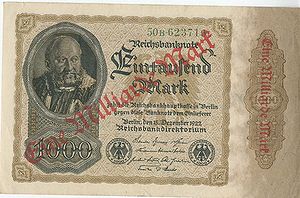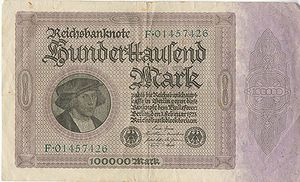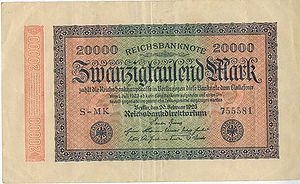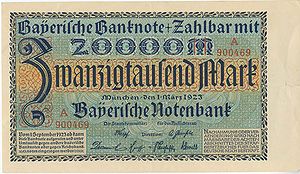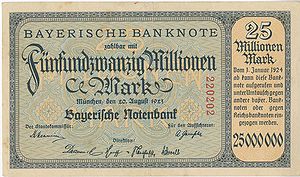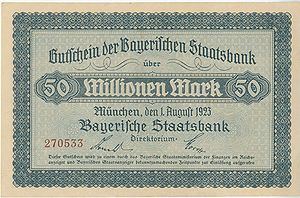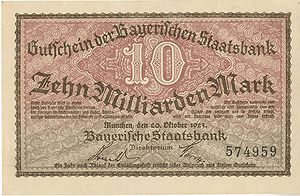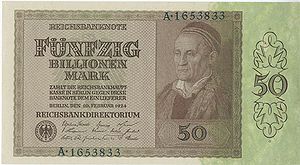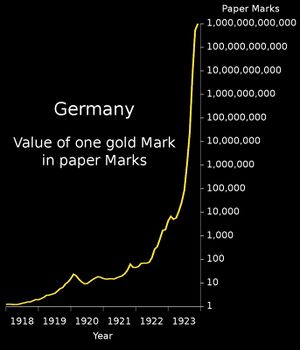
Inflation, which already began during the First World War, could not be stopped after the end of the war, as government expenditure continued to be financed by debt. In the crisis year of 1923, inflation reached its peak as hyperinflation. The beneficiaries of inflation were all borrowers (the state, entrepreneurs, farmers), since they could easily pay off their now worthless debts and finance investments. It had an expropriating effect on recipients of a fixed income and holders of securities.
Definition and Recording of Inflation
Inflation means a prolonged rise in the general price level or a prolonged, continuous depreciation of money. Inflation processes can be recorded using the quantity theory of money or equation of exchange by American economist Irving Fisher (1867-1947). This roughly simplifying equation to be understood as a definition is M*v = P*T. M is the nominal amount of money available in an economy (in particular banknotes in circulation and bank deposits) and v is the turnover rate of money, i.e. the speed at which money changes hands through transactions such as purchases. P is the average price per transaction rising in an inflation process; T is the number of transactions during the period considered. In broad terms, T is also the real range of goods and services available during the period. If the equation is resolved according to P, the driving factors of inflation become apparent: A sharp rise in the money supply and/or an increase in turnover and/or a decrease in the number of transactions and/or a decrease in real supply.
Causes and Start of the Weimar Inflation
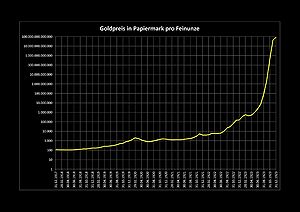
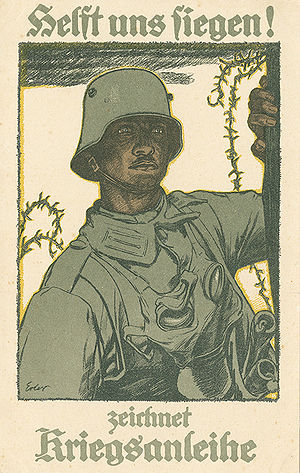
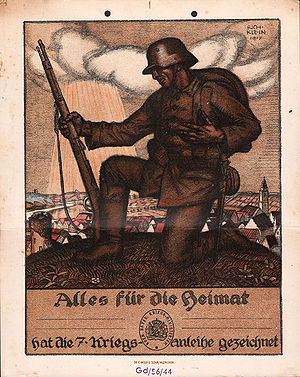
The causes of inflation during the first years of the Weimar Republic had already been established during the First World War: The money supply (cash and book money) had been greatly inflated by the issue of debt instruments to finance the war on the one hand, while the production of war goods instead of civilian goods led to a shortage of goods on the other hand. Finally, the one-third cover of the German gold mark had to be abandoned in 1916. In view of the rise in the price of everyday goods, which was higher than the increase in nominal wages, real wages fell until 1917. However, when these rose again in 1918, the physical shortage of goods meant that civilian demand could only be met in part.
In the turmoil after the end of the First World War, moderate inflation was therefore inevitable in Germany, and even welcome in order to quickly place returning soldiers in the civilian work process. On the one hand the disabled war veterans and unemployed had to be supported with money, on the other hand the war economy had to be laboriously converted back to the production of civilian investment goods and in particular consumer goods to overcome the shortage of goods. State bankruptcy through an official declaration of not wanting to repay the internal state debt in the form of subscribed war bonds was out of the question because of the destabilising social effects.
Although the tax reforms by the Reich's Finance Minister Matthias Erzberger (1875-1921) were intended to curb inflation and balance the state budget, they remained ineffective. The state had to take out further loans from the Reichsbank to plug the gaps in the budget. Now the money supply M began to rise more and more, also because resourceful companies began to buy more material assets on credit in order to repay them later with devalued money. From June 1921, confidence in the mark began to dwindle and everyone began to hastily invest their money but also low-interest loans in material assets faster and faster; this increased the turnover rate v. The progressive decline of the mark and the extremely unclear situation about the amount of reparations claims made entrepreneurial decisions seem profitable which later proved to be wrong decisions.
The Path to Hyperinflation
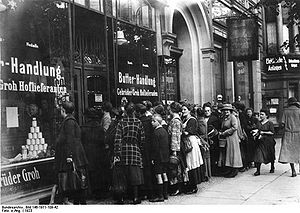
A credit crisis and a lack of means of payment developed in the middle of 1922. This had two consequences: On the one hand, the money supply increased as a result, but only minimally, since local authorities or companies were now issuing emergency money that was stable in value for the time being due to its initial shortage in supply, but on the other hand companies now had to restrict production and cut jobs, which reduced the supply of real goods.
All the dams finally broke with the "Occupation of the Ruhr" since January 1923, when industrial production in the Ruhr area plummeted massively and the Reich government financed the passive resistance at the Ruhr by exorbitantly expanding the printing of paper money, which increased the money supply M. The Ruhr District was not only a major industrial centre but also a major source of income. Since all trust in the mark was now lost and everyone therefore invested every single received mark in tangible assets as quickly as possible, the turnover rate v rose to a previously unprecedented level.
Figures on German Hyperinflation
In October 1923, the state's tax revenues covered just 1% of the Reich's expenditure; 99% were financed by printing paper money. In mid-November 1923, 99% of short-term government debt was in the Reichsbank's portfolio, plus almost 40 trillion marks in private commercial bills. 400 trillion marks of cash were also in circulation in November 1923; meanwhile, the circulation of emergency money also reached a similarly estimated magnitude. While one kilogram of rye bread cost 163 marks and 1 kilogram of beef 1,800 marks in Berlin on 3 January 1923, the corresponding prices were 233 billion marks and 4 trillion 800 billion marks on 19 November 1923. One US dollar cost 47,670 marks on average per month in May 1923 and then 4,200,000,000,000 marks on 20 November.
Winners and Losers of Inflation
The losers of inflation are consequently all recipients of a fixed, very sluggishly adjusting monetary income or generally the holders of monetary claims. In the German hyperinflation of 1922/23, the expropriating effect of these groups was cemented by the fact that German jurisdiction in the spring of 1923 decided that "one mark equals one mark" when repaying loans: a pre-war loan based on the gold mark could now be repaid in 1923 with the same amount of worthless paper money. Of course, this principle also applied to the repayment of war bonds by the state: In November 1923, the Reich's total internal war debt of 154 billion marks corresponded to a purchasing power of only 15.4 pfennigs, calculated in the purchasing power of the pre-war year 1913. The big losers were therefore the holders of war bonds, similarly the big "winner" was the state. As recipients of fixed incomes, however, it was not only the pensioners who were losers, but also civil servants and all "belatedly" adjusted salaried employees, recipients of a fixed rental income and all holders of savings accounts. Banks lost their equity capital, as did public and private insurance companies that had invested their capital stock in "money".
The winners were those who anticipated the development of inflation and, as astute entrepreneurs like Hugo Stinnes (1870-1924), bought material assets such as businesses, land or durable consumer goods in good time, preferably on credit, or, like many farmers, served old debts with worthless paper money. This enabled many farmers, especially of course in Bavaria, which still had a strong agricultural structure, to get rid of their mortgages that had often burdened generations on the one hand, and to press ahead with the modernisation of their farms through new technologies on the other. However, once the currency stabilised, this resulted in sales crises for agricultural products, which now drove farmers into new hardships.
Hyperinflation in Bavaria
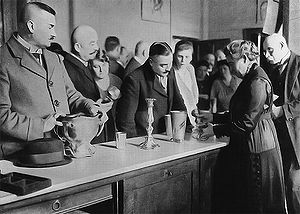
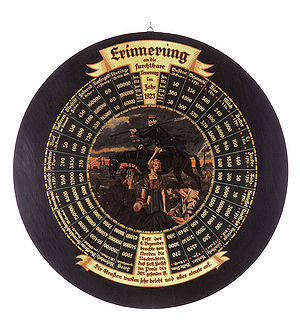
Hyperinflation was a phenomenon throughout the Reich. Nevertheless, there are specifics to Bavaria, which to a large extent are associated with Bavaria's economic structure at that time: at the time of hyperinflation, Bavaria was still largely shaped by agriculture but also had urban centres such as Munich, Nuremberg and Augsburg. While in the cities the industrial division of labour prevailed with corresponding market transactions to be settled by means of money, in rural villages some transactions could be settled in a non-monetary exchange. The rural population was therefore able to live self-sufficiently independent of money and the market either within the family, or at least in large parts within the self-help system in the village. The majority of farmers even benefited from hyperinflation because they could pay off their debts without any problems. Therefore it was relatively late that Bavarian municipalities or companies issued emergency money.
The situation was completely different in the urban population, which relied on the division of labour and market-monetary relations. Rents in particular created unrest here, alongside the disadvantages for recipients of wages and pensions. Therefore, alternating occurrences of "buying strikes" and "buying frenzies" are no more surprising during hyperinflation in Munich, for example, than excessive property crimes such as field and forest offences, especially against farmers who were "not dependent on money". Politically, Adolf Hitler (1889-1945) and his NSDAP benefited most from the highly charged mood.
Another problem arose from Erzberger's new financial constitution: the Reich's allocations of income and corporation tax revenue to the federal states, which were then passed on to the municipalities in part, were eroded by the rapid decline in monetary value. Since the internal Bavarian financial equalisation fund did not provide any relief here, it was finally abolished by the state government in 1923.
Banknotes from the Inflation Period
-
Reichsbank 1000 mark banknote, December 1922. (HVB Stiftung Geldscheinsammlung)
-
Reichsbank 100,000 mark banknote, February 1923. (HVB Stiftung Geldscheinsammlung)
-
Reichsbank 20,000 mark banknote, February 1923. (HVB Stiftung Geldscheinsammlung)
-
Bayerische Notenbank (Munich) 20,000 mark banknote, March 1923. (HVB Stiftung Geldscheinsammlung)
-
Bayerische Notenbank (Munich) 25 million mark banknote, August 1923. (HVB Stiftung Geldscheinsammlung)
-
Bayerische Staatsbank (Munich) 50 million mark banknote, August 1923. (HVB Stiftung Geldscheinsammlung)
-
Bayerische Staatsbank (Munich) 10 billion mark banknote, August 1923. (HVB Stiftung Geldscheinsammlung)
-
Reichsbank 50 trillion mark banknote, February 1924. (HVB Stiftung Geldscheinsammlung)
References
- Fritz Blaich, Der Schwarze Freitag. Inflation und Wirtschaftskrise, München 3. Auflage 1994.
- Costantino Bresciani-Turroni, The Economics of Inflation. A Study of Currency Depreciation in Post-War Germany, London 3. Auflage 1968.
- Martin H. Geyer, Verkehrte Welt. Revolution, Inflation und Moderne, München 1914-1924 (Kritische Studien zur Geschichtswissenschaft 128), Göttingen 1998.
- Carl-Ludwig Holtfrerich, The German Inflation 1914-23: Causes and Effects in International Perspectives, Berlin/New York 1986.
- Karsten Laursen/Jørgen Pedersen, The German Inflation 1918-1923, Amsterdam 1964.
Further research
External links
Related articles
- Demobilmachung, 1918-1923 (ökonomisch, gesellschaftlich, kulturell)
- Notgeld
- Regiefranken, 1923/24
- Reparationen (Weimarer Republik)
- Ruhrbesetzung, 1923
- Währungsreform, 1923/24
Hyperinflation
Cite
Helmut Braun, Inflation, 1914-1923, published 22 January 2007, english version published 27 February 2020; in: Historisches Lexikon Bayerns, URL: https://www.historisches-lexikon-bayerns.de/Lexikon/EN:Inflation,_1914-1923 (21.12.2025)

